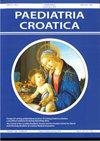在先天性脑畸形儿童中引入辅助和替代交流的有效性
Q4 Medicine
引用次数: 0
摘要
患有先天性脑畸形的儿童的临床人群是非常不均匀的,由大脑受损部分的位置和严重程度来定义。发展概况包括从严重的智力困难和无法通过言语表达到轻度的临床表现,这意味着沟通,语言和言语的发展困难。患有先天性脑畸形的儿童通常依赖于辅助和替代交流(AAC)方法,使他们能够表达自己或更好地理解语言。本研究的目的是描述先天性脑畸形和原发性小头畸形男孩的沟通、语言和言语特征,并确定引入辅助和替代沟通对他的沟通、语言和言语发展的有效性。言语治疗干预为期5个月。使用低技术含量的交流工具(交流书)和高技术含量的交流工具(非专业平板电脑)来实现干预的既定目标。使用视频分析记录交流发展,使用麦克阿瑟-贝茨交流发展量表(CDI)收集理解和单词生成数据。在五个月的干预期间,男孩们在以下方面观察到积极的变化:a)沟通功能模式,即他为特定功能进行沟通的频率;b)语言产生:词汇量和语言复杂性的增加;c)使用言语作为主要的沟通手段。沟通工具使用模式的变化,特别是在引入增强和替代沟通后,言语使用的显著提高,与之前关于增强和替代沟通作为循证干预的重要性的研究是一致的。本文章由计算机程序翻译,如有差异,请以英文原文为准。
The effectiveness of of the introduction augmentative and alternative communication in a child with congenital brain malformations
The clinical population of children with congenital brain malformations is very heterogeneous, being defined by the location and severity of the damaged part of the brain. Developmental profiles range from severe intellectual difficulties and inability to express through speech to milder clinical presentation that imply difficulties in the development of communication, language and speech. Children with congenital brain malformations often rely on augmentative and alternative communication (AAC) methods which enable them to express themselves or better understand language. The aim of this study is to describe the characteristics of communication, language and speech in a boy with congenital brain mal- formations and primary microcephaly and to determine the effectiveness of the introduction of augmentative and alternative com- munication on his communication, language and speech development. The speech therapy intervention was organized for 5 months. A low-tech tool (a communication book) and a high-tech communication tool (a nonspecialized tablet) were used to achieve the set goals of the intervention. Communication development was recorded using video analysis, and comprehension and word production data were collected using the MacArthur—Bates Communicative Development Inventory (CDI). During the five months of intervention, positive changes were observed in the boys’: a) patterns of communication functions, i.e., the frequency with which he communicate for specific functions, b) language production: increase in vocabulary size and language complexity, and c) use of speech as a primary mean of communication. The changes in communication tool use pattern, particularly the significant gains in the use of speech after the introduction of augmentative and alternative communication, are consistent with previous re- search on the importance of augmentative and alternative communication as an evidence-based intervention.
求助全文
通过发布文献求助,成功后即可免费获取论文全文。
去求助
来源期刊

Paediatria Croatica
医学-小儿科
CiteScore
0.20
自引率
0.00%
发文量
0
审稿时长
6-12 weeks
期刊介绍:
In the inaugural 1956 issue of the journal, the editor Dr Feđa Fischer Sartorius outlined the journal''s vision and objectives saying that the journal will publish original papers on the development, pathology, and health care of children from the prenatal period to their final biological, emotional and social maturity. The journal continues this vision by publishing original research articles, clinical and laboratory observations, case reports and reviews of medical progress in pediatrics and child health.
 求助内容:
求助内容: 应助结果提醒方式:
应助结果提醒方式:


